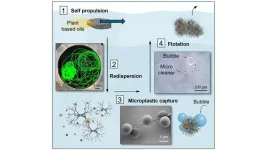Hypersonic simulation in 3D exposes new disturbances
2025-03-26
(Press-News.org) At hypersonic speeds, complexities occur when the gases interact with the surface of the vehicle such as boundary layers and shock waves. Researchers in the Department of Aerospace Engineering in The Grainger College of Engineering, University of Illinois Urbana-Champaign were able to observe new disturbances in simulations conducted for the first time in 3D.
Fully 3D simulations require a great deal of processing power, making the work expensive to compute. Two things made it possible for Deborah Levin and her Ph.D. student Irmak Taylan Karpuzcu to conduct the research: Time on Frontera, the National Science Foundation-funded leadership-class computer system at the Texas Advanced Computing Center and software developed by in previous years by several of Levin’s former graduate students.
“Transitioning flows are 3D and unsteady in nature, regardless of the flow geometry. Experiments were conducted in 3D in the early 2000s didn't provide enough data to determine any 3D effects or unsteadiness because there weren’t enough sensors all around the cone-shaped model. It wasn’t wrong. It was just all that was possible then,” said Karpuzcu. “We have those data to compare, but having the full picture now in 3D, it’s different. Normally, you would expect the flow around the cone to be concentric ribbons, but we noticed breaks in the flow within shock layers both in the single and double cone shapes.”
Karpuzcu said they observed the breaks near the tip of the cone, and with a shock wave near where the air molecules were closer together making them more viscous and at Mach 16.
“As you increase the Mach number, the shock gets closer to the surface and promotes these instabilities. It would be too expensive to run the simulation at every speed, but we did run it at Mach 6 and did not see the break in the flow.”
Karpuzcu said the cone geometry represents a simplified version of many hypersonic vehicles and understanding how the flow affects surface properties can help lead to design considerations.
“Our group’s in-house software made it efficient to run the simulation in parallel processors, so it’s much faster. There were already data from experiments under high-speed conditions so we had some intuition about how the simulations would look, but in 3D we found breaks that we didn’t expect to see.”
He said the most difficult part of the work for him was in analyzing why the break in the flow was happening.
“The flow should be going in all directions, but uniformly. We needed to justify what we were seeing. Our literature review indicated that a linear stability analysis based on triple-deck theory can be applied to this flow. After analyzing the complex formulations and connecting them to our case, we developed a code to numerically simulate the problem again. Running the 3D direct simulation Monte Carlo simulation is hard, but then we set up a second computer program to make sure everything works and is within the limits for our flow conditions. When we did that, we saw the break in two big chunks in 180-degree periodicity around the cone.”
Karpuzcu said the beauty of the direct simulation Monte Carlo is that it tracks each air molecule in the flow and captures the shocks.
“When you use other methods to calculate fluid dynamics, it's all deterministic. When we introduce a particle to the flow field, there is a probability of that particle colliding with other particles or any solid surfaces that's calculated on physics-based formulas, but the output is a roll of the dice. The Monte Carlo method does random, repetitive attempts. It’s more extensive than classical computational fluid dynamics methods and we’re tracking billions of particles. This makes sure there are enough particles within the flow field and collisions are captured properly.”
The study, “Loss of axial symmetry in hypersonic flows over conical shapes,” by Irmak T. Karpuzcu and Deborah Levin, is published in the journal Physical Review Fluids. DOI: 10.1103/PhysRevFluids.10.033901
END
[Attachments] See images for this press release:

ELSE PRESS RELEASES FROM THIS DATE:
2025-03-26
EMBARGOED FOR RELEASE UNTIL 4:00 P.M. ET, WEDNESDAY, MARCH 26, 2025
MINNEAPOLIS — People living in more disadvantaged neighborhoods may be more likely to develop dementia than people living in neighborhoods with fewer disadvantages, according to a study published on March 26, 2025, online in Neurology®, the medical journal of the American Academy of Neurology. The study does not prove that neighborhood factors cause dementia; it only shows an association.
Neighborhood status was determined by factors such as income, employment, education and disability.
“Our findings show that the community in which you live influences your risk of developing dementia,” ...
2025-03-26
EMBARGOED FOR RELEASE UNTIL 4:00 P.M. ET, WEDNESDAY, MARCH 26, 2025
MINNEAPOLIS — People who have early signs of heart problems may also have changes in brain health that can be early signs of dementia, such as loss of brain volume, according to a meta-analysis published on March 26, 2025, online in Neurology®, the medical journal of the American Academy of Neurology. The meta-analysis does not prove that early heart problems cause loss of brain cells; it only shows an association.
“This review shows that better ...
2025-03-26
COVID infection has been linked to higher risk of autoimmune disorders, including rheumatoid arthritis and type 1 diabetes. But why the virus might cause the body’s immune system to go haywire remains unknown, making it difficult to develop therapies to avoid autoimmunity. One hypothesis is that viral “molecular mimics” that resemble the body’s own proteins trigger an immune response against the virus—and healthy tissues get caught in the crossfire.
Now, with advanced data analysis and machine learning, scientists have identified a set of COVID-derived ...
2025-03-26
FOR IMMEDIATE RELEASE
March 26, 2025
BATON ROUGE – Scientists at Pennington Biomedical Research Center have gained greater clarity in the brain regions and neurons that control metabolism, body temperature and energy use. Featured in the February edition of the journal Metabolism, Dr. Heike Münzberg-Gruening and a team of researchers discovered which chemicals influence the signals that control how much energy the body uses. In “Leptin Receptor Neurons in the dorsomedial hypothalamus require distinct neuronal subsets for thermogenesis and weight loss,” researchers laid out the pathways, chemicals, neurons ...
2025-03-26
In a new paper, researchers at North Carolina State University show proof of concept for a system that, in a single cycle, actively removes microplastics from water.
The findings, described in the journal Advanced Functional Materials, hold the potential for advances in cleansing oceans and other bodies of water of tiny plastics that may harm human health and the environment.
“The idea behind this work is: Can we make the cleaning materials in the form of soft particles that self-disperse in water, capture microplastics as they sink, and then return to the surface with the captured microplastic contaminants?” said Orlin Velev, the S. Frank and Doris Culberson Distinguished ...
2025-03-26
HOUSTON ― The University of Texas MD Anderson Cancer Center today announced that Jeffrey E. Lee, M.D., an internationally regarded leader in the field of oncology, has been appointed chief medical executive (CME) effective April 1.
Prior to his appointment, Lee served as CME ad interim, demonstrating strength as a leader committed to advancing the institution’s efforts in research, patient care, prevention and education. Assuming the role of CME is the culmination of Lee’s 34-year tenure at the institution, where he has made substantial contributions in the field ...
2025-03-26
Life’s essential functions are powered by a set of compounds called metabolites, which are involved in every natural process including producing energy, regulating cell activity and keeping the body’s systems in balance. Tracking these molecules offers a window into the onset and status of many diseases, overall health, response to treatment and the intricate workings of biological systems.
However, today’s metabolite sensing methods fall short. Most rely on resource-intensive lab tests that give only brief snapshots from isolated samples. The few sensors that can track metabolites continuously are largely limited to detecting blood sugar.
An interdisciplinary ...
2025-03-26
REDWOOD CITY, Calif. (March 26, 2025) — The Chan Zuckerberg Initiative (CZI) announced a new grand challenge to develop groundbreaking imaging technologies to transform how scientists observe, measure and understand living cells and organisms. CZI’s two powerhouse institutes, CZ Biohub San Francisco and CZ Institute for Advanced Biological Imaging, will leverage their complementary expertise to form a new Biohub unmatched in the field of life science imaging research. They will combine their teams at a new science campus in Redwood City, Calif., adjacent to CZI ...
2025-03-26
In an era where data privacy concerns loom large, a new approach in artificial intelligence (AI) could reshape how sensitive information is processed.
Researchers Austin Ebel and Karthik Garimella, Ph.D students, and Assistant Professor of Electrical and Computer Engineering Brandon Reagen have introduced Orion, a novel framework that brings fully homomorphic encryption (FHE) to deep learning — allowing AI models to practically and efficiently operate directly on encrypted data without needing to decrypt it first.
The implications of this advancement, ...
2025-03-26
ACM, the Association for Computing Machinery, today named Torsten Hoefler, a Professor at ETH Zurich, the recipient of the 2024 ACM Prize in Computing for fundamental contributions to high-performance computing and the ongoing AI revolution. Hoefler developed many of the core capabilities of modern supercomputers and defined key aspects of the algorithms for distributing AI models on them.
The ACM Prize in Computing recognizes early-to-mid-career computer scientists whose research contributions have fundamental impact and broad implications. ...
LAST 30 PRESS RELEASES:
[Press-News.org] Hypersonic simulation in 3D exposes new disturbances




